Ever scrolled through a post and thought, “I want my brand to feel this real”?
We’ve seen how powerful authentic user-generated content can be when it’s done right. UGC ads are a way to build real trust, spark engagement, and connect with your audience in a meaningful way.
In this guide, we’re excited to take you through the top 10 UGC creator marketplaces with global talent.
We’ll help you discover platforms where you can work with creators from all over the world. Whether you’re looking for cost-effective options or high-quality, scalable campaigns, we’ll show you how to tap into diverse, authentic content that truly resonates with your customers.
By the end of this article, you’ll know where and how to find creators who can bring your brand stories to life, helping your campaigns stay fresh, impactful, and relevant no matter the market.
Let’s dive in.
UGC creator marketplaces are platforms that connect brands like yours with UGC creators who produce authentic, ready-to-use content, everything from photos and videos to reviews and social posts for:
Creator marketplaces are different from traditional influencer marketplaces, which usually focus on audience size and distribution.
Creator marketplaces, on the other hand, connect you with smaller creators who prioritize content that feels real and relatable. In fact, 90% of consumers say authenticity is the key factor when deciding which brands they like and support. That’s just how much genuine content matters.
And unlike general freelancer platforms, UGC creator marketplaces are specialized in connecting brands with actual creators. These people aren’t just freelancers; UGC is what they do for a living, so they truly understand social-first formats, short-form storytelling, and performance content.
And you need good creators because solid UGC posts can drive 28% more engagement than brand-created content. Besides, ads using UGC wisely can deliver up to 4 times higher click-through rates.
But you need to work with specialized UGC creators to make sure your content looks authentic and performs well.
UGC creator marketplaces can supercharge your campaigns, helping you scale efficiently while keeping content authentic. Here’s why you should consider them:
So, now that you know why you should pick a creator marketplace, here are 10 of the best ones.

Website: Billo – billo.app
Billo is a user-generated content (UGC) marketplace that connects brands with creators to produce authentic short-form video ads, especially for platforms like TikTok, Instagram, and Facebook.
What sets Billo apart is its data-driven approach.
It claims to be the first creator marketing stack that combines video production with performance insights, drawing from over 326,000 video ads and $500M in purchase data.
Brands can brief creators, manage video production, and scale top-performing content into paid ads, all in one place. Here are some tricks you can follow to get the best results, according to Reddit:
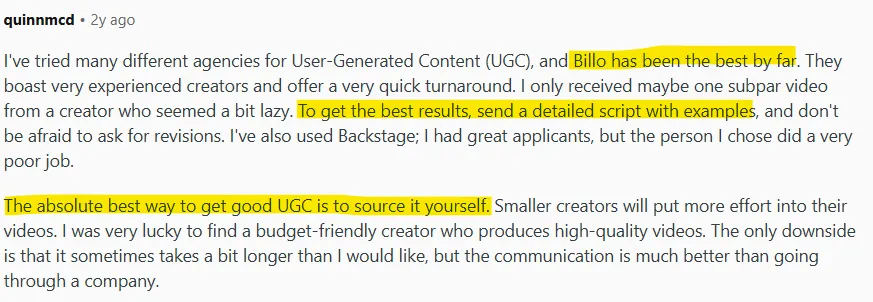
It’s especially popular for e-commerce and DTC brands looking to scale content without big agency costs.
We like it because you get access to thousands of vetted creators, which means fast, diverse, and localized content that performs.
Billo is also cost-effective; there are no subscriptions; you only pay for what you need. Creators deliver content tailored to social media performance, and you retain usage rights, which is ideal for paid campaigns.
It’s not meant for cinematic-quality shoots but excels at delivering quick, conversion-friendly videos.
Pros:
Cons:
Pricing plans: Launch plan starts at $500

Website: Trend.io – trend.io
Trend.io is a creator marketplace designed to help brands quickly source short-form video and photo content from vetted creators.
It’s built for efficiency: you post a campaign brief, select from a pool of creators who apply, then approve content and track deliverables from a centralized dashboard.
What makes Trend unique is that it combines influencer marketing with scalable UGC production. You can retain full content rights and can repurpose videos and photos across paid ads, social media, and e-commerce.
Trend.io is also geared toward micro-creators and niche influencers who produce authentic, engaging content.
The pricing model is straightforward: you pay per deliverable, and creators are pre-paid through the platform, reducing negotiation problems.
The platform is especially helpful for DTC and e-commerce brands that want a fast, consistent flow of high-performing content without managing dozens of one-off freelancer deals or agency retainers.
It’s particularly well-suited if you’re testing new products, launching campaigns, or trying to scale UGC content without burning out their internal team.
Pros:
Cons:
Pricing plans: Starts at $500 (up to 6 videos or 15 photos)

Website: Collabstr – collabstr.com
Collabstr is an influencer and creator marketplace that connects brands with creators across Instagram, TikTok, YouTube, and LinkedIn.
Just like other marketplaces, it has a “self‑service” style: brands search for creators by platform, niche, follower count, location, and price; creators showcase packages and you can buy a campaign directly from their profile.
The platform also holds payments in escrow until the creator delivers the content, giving brands more security.
And companies appreciate it. After all, there are 250,000+ brands and hundreds of thousands of creators reportedly on the platform.
What’s particularly unique:
Pros:
Cons:
Pricing plans: Starts at $299/ month; free version available

Website: JoinBrands – joinbrands.com
JoinBrands is an all‑in‑one creator‑marketing platform designed for brands to tap into a wide pool of UGC creators, influencers, and affiliates through one streamlined marketplace. According to their site, they support over 250 K UGC creators, 100 K TikTok shop affiliates, and more than 10 K influencers, which reflects a very large talent ecosystem.
What sets JoinBrands apart is its emphasis on product‑driven content creation (e.g., for e‑commerce brands) and “autopilot” campaign flows. You can upload your product, set up a campaign brief, select creators, manage delivery, and then even run “Spark Ads” from creator profiles, all in a single workflow.
Another unique aspect is their claim to deliver content quickly (images within ~5 days, videos within ~10) and guarantee rights transfer to the brand.
This platform is particularly aligned with brands that need scalable visual content for social, e‑commerce, and affiliate channels, without needing to manage dozens of individual micro‑deals manually.
Pros:
Cons:
Pricing plans: Starts at $99; free tier available
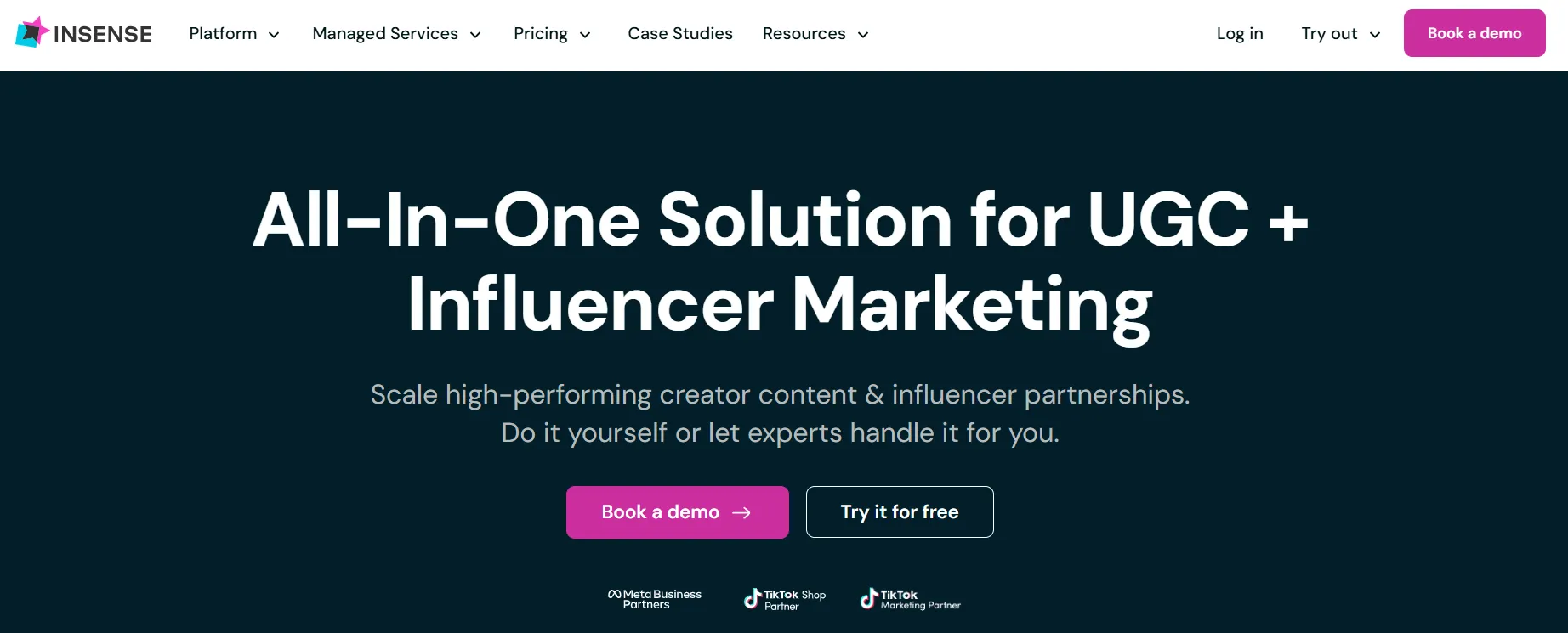
Website: Insense – insense.pro
Insense is a creator marketplace and content‑production platform for brands that want to scale UGC (user‑generated content), influencer collaborations, and ad‑ready creative assets.
What sets Insense apart is the breadth and structure of its offering: you get access to a vetted network of over 70,000 creators across 35‑plus countries, filtered by platform, category, budget, language, and more.
The platform supports everything from brief creation and creator sourcing to rights/licensing, payments, and campaign tracking.
It covers a wide spectrum of campaign types: raw and edited UGC for paid ads, influencer posts, TikTok Spark Ads, Meta partnership whitelist ads, product seeding, affiliate programs, etc.
Insense is particularly attractive for DTC and e‑commerce brands that need both volume and performance. You can launch quickly (creator applications even within 48 hours) and receive deliverables in about 14 days, according to their website.
Pros:
Cons:
Pricing plans: Starts at $650/ month (self-service)
Side note: What qualifies as poor user-generated content? Here are 12 bad UGC examples to see what you should avoid.
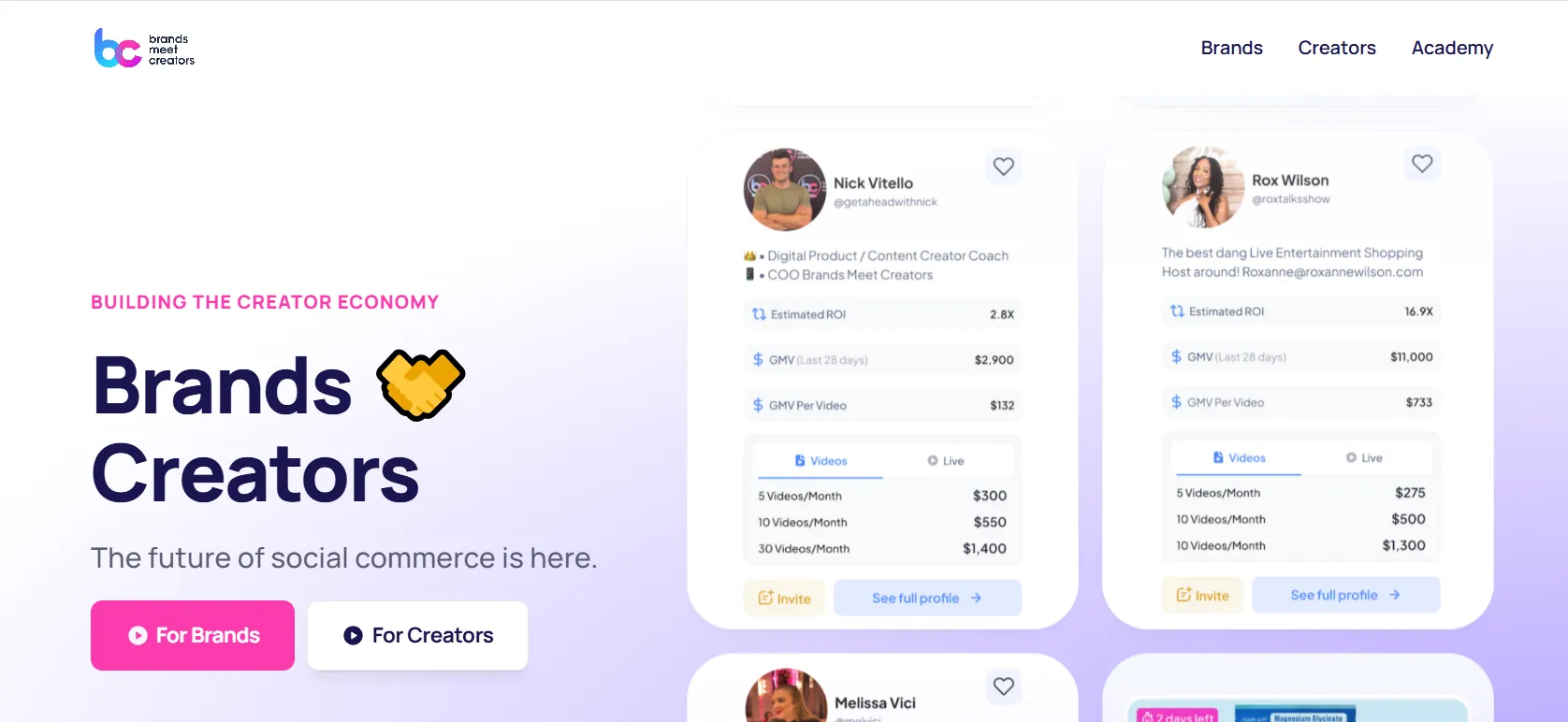
Website: Brands Meet Creators – brandsmeetcreators.com
Brands Meet Creators is a platform built to directly link brands with content creators, like its peers above.
What sets BMC apart is its “creator‑friendly” model: it’s 100% free for creators, and it gives creators full control over their rates, usage rights, and communication channels.
For brands, the platform offers features to scale creator rosters, track deliverables, and estimate ROI before hiring. You can post jobs, access a pre‑vetted creator network, track performance and payments through a dashboard, and manage large creator teams at scale.
Besides, you get brands directly in your inbox. In the words of Kirk Axley of the UGC Club:

Another distinctive angle: BMC emphasizes long‑term partnerships over one‑off gigs. They position themselves not just as a gig‑marketplace but as a tool for brands to build a consistent content machine through creators, and for creators to build ongoing brand relationships.
In short, BMC works as a bridge that gives creators autonomy (set your rates, keep usage rights) while giving brands workflow, scale, and data‑driven control in their creator programs.
Pros:
Cons:
Pricing plans: Available upon request; free for creators
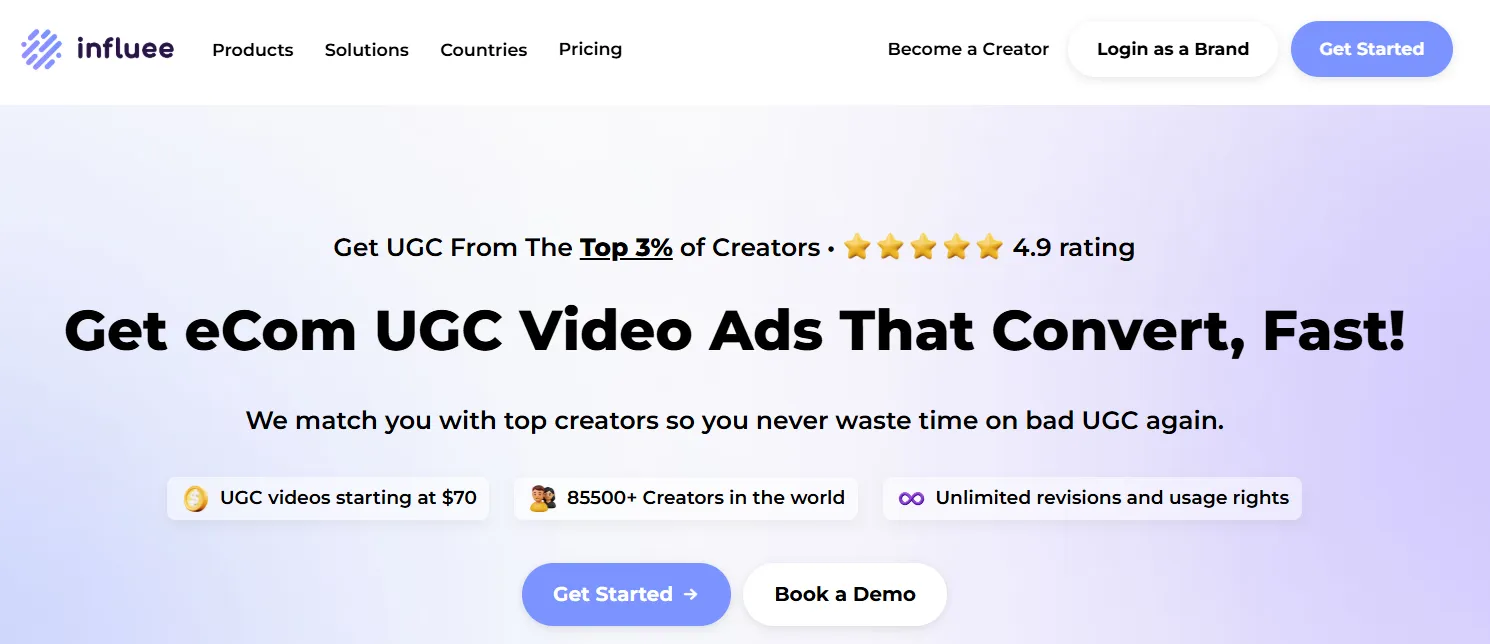
Website: Influee – influee.co
Influee claims a network of over 80,000 vetted creators worldwide, specializing in short‑form video, unboxings, testimonials, talking‑head clips and UGC that’s ad‑ready.
What sets Influee apart is its combination of speed, structure, and simplicity. Brands upload a brief, pick creators, and receive content, usually within 7‑10 days, complete with usage rights and unlimited revisions.
They also support multilingual assets and multiple formats (Reels, TikTok, Facebook feeds) and emphasize budget‑friendly entry points.
Another unique feature: Influee handles the binding details: UGC contracts, legal rights, and creator payment.
That way, you don’t have to build the infrastructure yourself.
Pros:
Cons:
Pricing plans: Starts at $229/month for 10 influencer collaborations

Website: Twirl – usetwirl.com
Twirl is a full‑service user‑generated‑content creator marketplace to scale social‑first video and image content with a vetted creator network.
The platform claims to offer access to 5,000+ creators across the UK, US, and Europe, covering niches from beauty and wellness to apps, pets, food & beverage, and more.
Twirl positions itself as the bridge between tech‑driven (platform) efficiency and hands‑on service.
That means you can choose a self‑service workflow or a managed service where Twirl helps handle scripting, creator matching, editing, and strategic support. On the other hand, both of these options are fairly expensive compared to other creator marketplaces in this review.
Either way, you’ll have a clear and simple pay‑per‑video model with unlimited usage rights included, clean and edited formats in multiple aspect ratios, and quick turnaround.
Because it’s built for advertising, e‑commerce, and social channels, Twirl focuses on deliverables that are ad‑ready (for platforms like TikTok, Instagram, and Meta) with creators who understand how to shoot for performance.
Pros:
Cons:

Pricing plans: Starts at $475/ video (self-service)
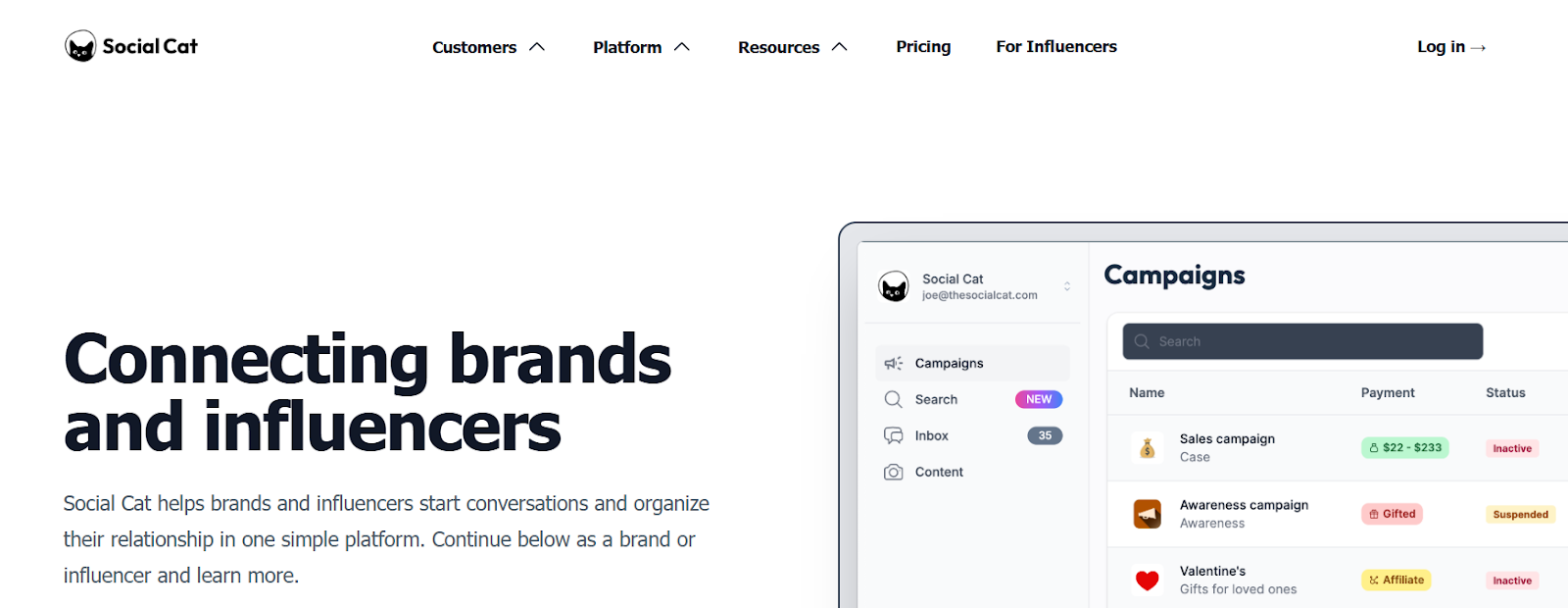
Website: Social Cat – thesocialcat.com
Social Cat is mostly catering to micro‑influencers and growing brands. Their marketplace boasts over 500,000 creator profiles and more than 2,000 brands actively using the service, which means it’s pretty successful.
What makes Social Cat stand out is its focus on affordability, ease of use, and micro‑influencer engagement. Brands can search creators by niche, engagement rate, follower count, and location, and get licensing rights for content.
Besides, you can get tools like “influencer gifting” (product‑for‑post), campaign tracking, and content galleries optimized for Instagram, TikTok, and Shopify stores.
Pros:
Cons:
Pricing plans: Starts at $99/ month
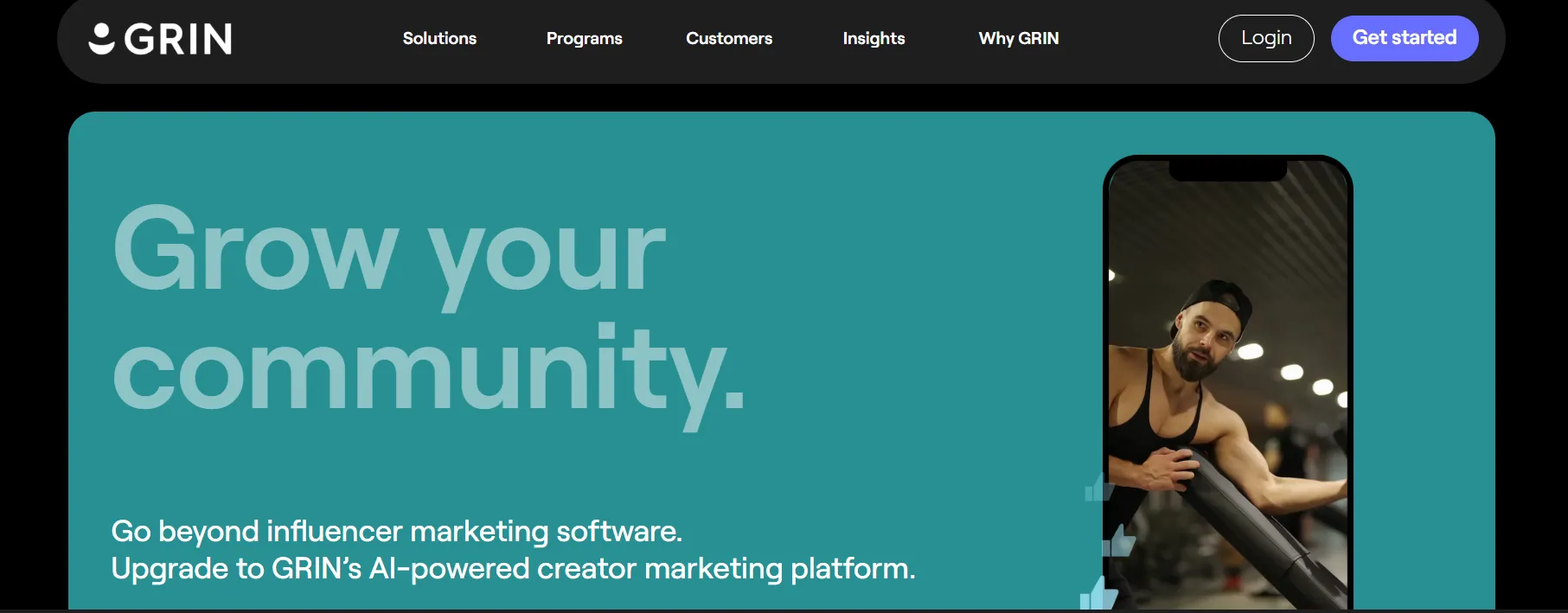
Website: GRIN
GRIN is an all‑in‑one creator‑management platform designed especially for e‑commerce brands wanting to build, scale, and optimize creator and influencer programmes.
What sets GRIN apart is its deep integration with e‑commerce systems (for example, Shopify, WooCommerce, Magento). That means it’s easier for you to manage product seeding, affiliate links, gifting, shipping, and track direct ROI from creators.
The platform supports discovery, outreach, contracts, content approval, rights/licensing, campaign management, and analytics, so it’s genuinely useful.
Besides, GRIN emphasizes authentic creator relationships over purely transactional influencer deals. The idea is long‑term partnerships rather than one‑off posts, just like we’ve seen for Brands Meet Creators.
Pros:
Cons:
Pricing plans: 3 pricing tiers; details available upon request
When we evaluate UGC creator marketplaces, we always look at six key dimensions: the ones that truly move the needle on ROI, brand consistency, and scalability. Before you pick a platform, here’s what’s worth paying attention to:
The first question is simple: are you optimizing for cost or creative excellence?
If your goal is to test fast and cheap, go for cost‑efficient marketplaces with big creator pools. They make it easy to try multiple creatives without burning through your budget. From that point of view, remember that Meta recommends testing 3‑5 creative variations per ad set.
If your brand story and visual identity matter most, premium, managed platforms are worth it. They’ll guide the creative process and ensure quality control.
Your goals determine the right type of platform. If you’re producing paid ads, choose marketplaces that focus on short-form UGC videos optimized for Meta or TikTok. These typically get 2–3× higher engagement rates than brand-shot videos.
If you’re aiming for organic content or authentic reviews, go for marketplaces that feature creators who emphasize real community engagement instead of polished ad creatives.
This is where brand consistency can make or break a campaign. Curated platforms give you vetted, professional creators, which typically means you need fewer revision rounds because you get higher quality output.
For example, one UGC‑based acquisition campaign achieved a 31% lower CPA and 80% higher ROAS when compared to traditional video ads.
Open platforms, on the other hand, offer a massive creator pool but may require more hands‑on review because not all creators are top-notch.
Pro tip: Our approach always includes reviewing creator portfolios, performance metrics, and sample work. That way, you make sure every creator you collaborate with fits your brand voice and maintains performance across campaigns.
The right tools can make campaign management ten times easier.
Use them to save valuable time with campaign setup and keep all creative assets organized in one place.
Think long‑term. Do you need a quick content boost or a steady UGC pipeline? Smaller brands can benefit from one‑off collaborations to validate messaging.
But if you’re scaling, you’ll want a system that supports batch orders and recurring briefs.
Finally, decide how hands-on you want to be. If your team prefers total control and quick turnaround, DIY marketplaces are great choices. If you’d rather save time, managed platforms include campaign managers who handle creator selection, briefing, and delivery, which can reduce internal workload considerably.
Choosing the right UGC creator marketplace is about finding the right balance between efficiency, quality, and scale.
We’ve seen firsthand how the right creators, tools, and workflows can transform UGC into a real growth engine for your brand, driving both engagement and measurable results.
But you have to pick the right platform, and this article took you through ten of the best ones. Remember to focus on your goals, and you will surely make a good choice.
Pro tip: We know managing multiple marketplaces and creators can quickly become overwhelming. inBeat Agency helps you scale UGC globally, keep quality consistent, and make sure every piece of content works hard for your ROI.
What is the difference between UGC creators and influencers?
UGC creators focus on producing authentic, relatable social media posts and creator ads tailored for your target audience, while influencers use their own following to promote products. UGC is made to blend seamlessly into your brand’s social media platforms, whereas influencer content feels more promotional or polished.
How much does UGC from marketplaces cost?
Pricing details vary depending on creator experience, variety of content types, and usage rights. Most marketplaces offer a wide range of costs. These start from $50 for simple videos to several hundred dollars for top-tier creators or bundles that include professional editing services and ad-ready delivery.
Can I use UGC in paid ads without additional rights?
Typically, no. You need explicit usage rights before running UGC as creator ads on social media channels or in affiliate marketing campaigns. Reliable marketplaces include these permissions in their comprehensive campaign management tools, ensuring your brand stays legally covered while scaling ad distribution.
Are UGC marketplaces better than hiring creators directly?
Marketplaces simplify the process by handling vetting, contracts, and strategic planning, saving brands time. They’re ideal when you need multiple assets fast or consistent, polished content. However, hiring creators directly can offer closer collaboration and more tailored storytelling. The best choice depends on your campaign goals and creative control needs.
What’s the best UGC marketplace for small brands vs. enterprises?
Small brands benefit from accessible pricing and plug-and-play workflows offered by platforms like Billo, which provide fast turnarounds and professional editing services. Enterprises, on the other hand, should look for solutions with comprehensive campaign management tools, deeper data insights, and access to top-tier creators across multiple social media platforms for large-scale, multi-channel execution.
